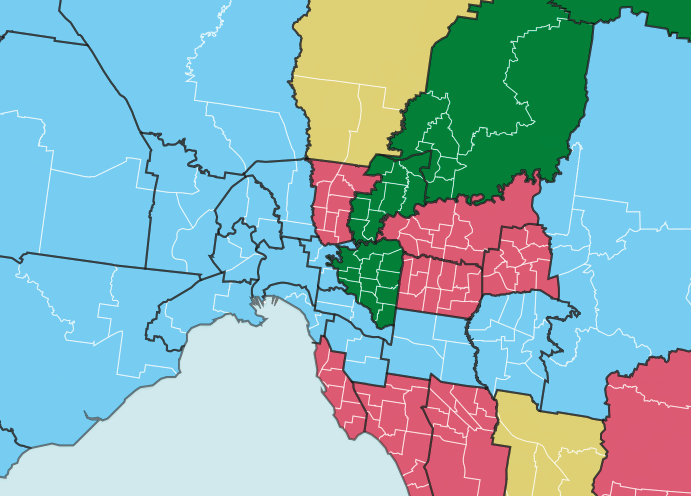Nominations closed yesterday for Victoria’s local government elections. Ballot papers will be sent out by mail in early October, with the votes being counted from October 24.
I’m not across the complexity of who is running so I won’t try and be across the candidates, but what I do now are the ward boundaries.
I posted a number of times earlier this year about the Victorian Labor government’s plans to change the rules around ward redistributions to push councils back towards single-member wards. The plans were pushed through parliament by the soon-to-be-disgraced local government minister, Adem Somyurek. He then used his newfound ministerial powers to switch a number of Victorian councils from multi-member wards to single-member wards, and prevented a number of others from switching in the other direction.
In particular I posted an analysis showing how the structure of Victorian local government elections has shifted away from single-member wards since 2004.
I have now finished my ward boundaries file for the 2020 Victorian council elections, which you can now download from my maps page. I’ve now posted full ward boundaries for the last four local government election cycles in the three biggest states, dating back to 2008.
In this post I’ll show some maps showing how many councillors each ward elects across the state, how the ratio of councillors to wards varies from place to place, and which councils were impacted by Somyurek’s changes. I’ve also updated the charts I posted in March to show the change in trajectory from the recent “reforms”.
Firstly, the changes. The Victorian Electoral Commission summarised which councils were changed here. Victorian councils undergo ‘representation reviews’ once every two terms, and only those councils who underwent reviews in 2019 and 2020 have been impacted.
For seventeen councils, Somyurek simply cancelled the current review, which means the 2016 boundaries will stay in place. None of these councils currently use single-member wards. Ten councils were not divided into wards, although reviews had recommended a switch to wards for four of those ten councils. The other seven use multi-member wards, and in some cases a part of the council is elected from single-member wards. With the exception of Casey, which is currently run by an administrator and won’t have an election this year, the rest are all rural.
There are two other rural councils where Somyurek changed the voting system from wards to an undivided council: Mansfield and Swan Hill. The representation review had recommended that decision for Swan Hill. These are also rural.
In the case of another twelve councils, Somyurek overrode the process to impose single-member wards. Four of these twelve councils were already using single-member wards, although the representation review had recommended a switch to multi-member wards in Boroondara and Murrindindi. With the exception of Murrindindi, the rest of these councils are in the Melbourne area.
This first map shows, at the ward level, which councils were switched by Somyurek’s decision.
All of the urban councils affected by these changes are in the eastern suburbs of Melbourne, which as we will see has created a significant difference in how councils are elected between the east and west. I don’t think we can chalk this difference up to a conscious decision by Somyurek: this simply reflects which councils were up for review in 2019-20.
These changes had a noticeable impact on the average ratio of councillors to wards across the state. This next chart is an update of a chart I posted in March, and it shows how the trend since 2004 has seen the ratio trending upwards as wards have been merged to create multi-member wards. This trend has been significantly turned around since Somyurek’s changes.
I’ve also mapped out this ratio of councillors to wards per local government area, and you can see that western Melbourne councils have much more councillors per ward than in the east, which has real impacts on how these elections run. If you want to see proportional representation in Melbourne councils, head west.
In March I also charted the number of councils using each electoral structure, and I have also updated this chart. You can see that the number of councils using single-member wards has doubled from eight to sixteen, with a noticeable decline in the use of multi-member wards.
And finally, this last map shows the number of councillors for every ward in the state. Undivided councils have five, seven or nine councillors, and I have merged these categories together.
I will be back with some analysis of the ward changes tomorrow, and am hoping to also do some other analysis of how federal election results map out on ward boundaries. I don’t plan on doing proper coverage of the results, but I will post an open thread on election day.




Do you know if anyone will be providing analysis of the council races? Labor have gone back to running endorsed candidates and with changes to ward boundaries in some areas there should be some interesting contests. LGAs like Brimbank seem to be continuing their old tradition of having 20+ “independents” running in every ward. Liberals are still not endorsing candidates but plenty of known Liberal members in the running. The Greens are running in many regional councils where they have never done so before.
Somyurek was on record about how this was a move to “Break the Greens business model” and I think it will work as intended. Some Greens will get up in Darebin and Moreland, but Labor are well positioned to retake both councils (especially the former). Greens will have a hard time in Cardinia and Dandenong despite having relatively popular incumbent councillors (though Kirwan isn’t recontesting Dandenong).
Greens will do ok where they can still contest multi member wards, especially with incumbents, but the party has a very long way to go to get back to where they were at the last council election, even without considering the harder electoral system.
Comments are closed.